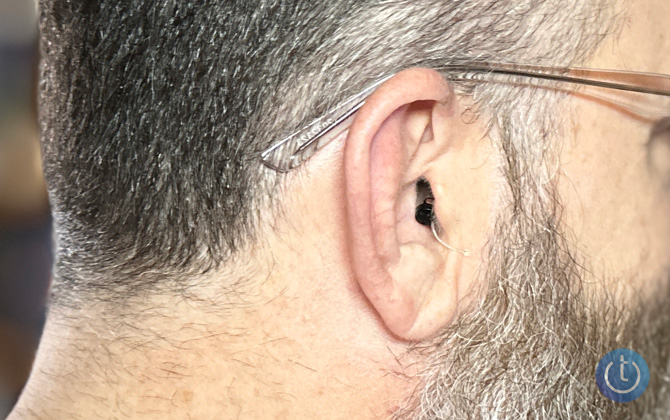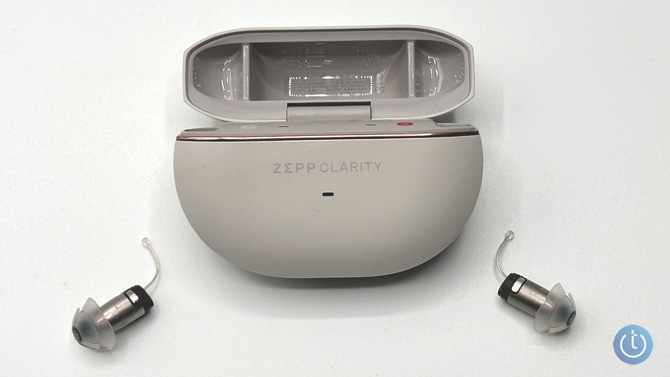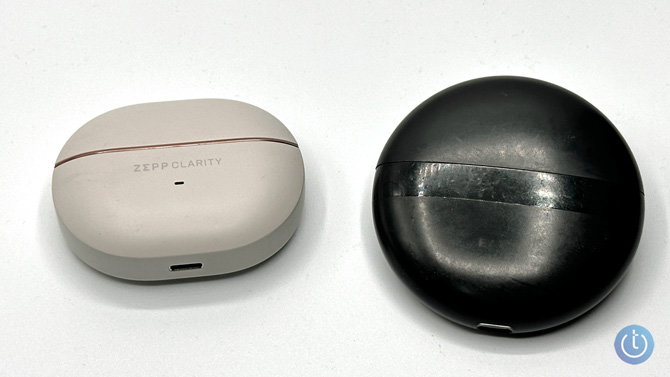We may earn commissions when you buy from links on our site. Why you can trust us.
Zepp Clarity Pixie OTC Hearing Aid Review: Eargo’s Worthy Competitor
With the Zepp Clarity Pixie, Eargo now has a worthy competitor. The Pixie delivers nearly the same excellent natural hearing clarity in the same nearly invisible in-ear bud form factor as the Eargo 7, my pick for the best OTC hearing aids, with a slightly wider variety of sonic tailoring options.

But I can’t help but think that Zepp missed an opportunity where price is concerned.
Yes, at $1,999 – discounted down to $1,799 for at least the holiday season – the Pixie is around $1,000 less than the Eargo 7 and around $250 less than the Eargo 6. These significant savings make it easy to recommend the Pixie over the Eargo 7 or 6. They all similarly and excellently correct your hearing, offer a variety of other hearing and operational enhancements and customizations, and offer nearly identical operational battery life. Plus, the Pixie fully recharge in just 2.5 hours vs. the four-hour Eargo recharge time and use a smaller case.
But it’s hard to recommend the Pixie over the less expensive and still comparatively excellent Eargo 5 (now discounted to $1,550) or a less expensive RIC (receiver in canal) alternative such as the Sennheiser All Day Clear or the Orka Two, which I am currently testing. Both these RIC models include Bluetooth music streaming and hands-free calling capabilities the Pixie and lack lacks, and both RIC models can be boosted to higher volume levels to overcome noisier situations than the Pixie or Eargo. And the Eargo 5 offers an audiologist’s help during setup and Eargo proactively checks in during the first months of use. While Zepp has excellent lifetime customer service, you're not immediately guaranteed an audiologist’s help.
Also, a few gnawing issues keep me from issuing a more full-throated recommendation for the Pixie.
| + Pros | – Cons |
|
|
Ergonomics
If you’re unfamiliar with Zepp, or its full name, Zepp Health, the 10-year-old company makes not only hearing aids and other consumer and commercial health products but also the popular Amazfit smartwatch.
Physically, the Clarity Pixie in-ear buds are nearly twins to the varying Eargo models. Buds from both companies measure less than three-quarters of an inch long. Each Eargo bud weighs .03 ounces/.85 grams, each Pixie weighs .039 ounces/1.1 grams, which, believe it or not, I could feel in my hand, although the nearly incidental weight difference disappears once you place the Pixies in your ears. Pixie’s added weight is a result of its titanium alloy construction, and they do feel a bit more substantial than the Eargo, which does not impact performance or comfort. Both include a translucent pull cord wire to make the buds easy to remove. Both the Pixie and the Eargo buds are 1PX7 water resistant, and both carry two-year warranties and 45-day no-worry returns.

Pixie includes only small and medium open and closed silicone dome tips along with a cleaning tool. Why no large-sized domes? Zepp says it has found that “99% of the users we have had fit into the domes we currently make,” which makes sense since you don’t want to seal your ear when wearing non-Bluetooth hearing aids.
Deciding between open or closed domes is a personal aural preference. The open provide a more natural sound but allows in extra ambient noise, while the closed do somewhat clog your canal but are better for conversations in noisy situations since they tend to dampen ambient noise and reduce feedback.
Charging
The oval beige Pixie recharging case is about a third smaller than the round black Eargo case, but both are flat and less than three-quarters of an inch thick, so equally pocketable. Both are recharged via a USB-C connection.

Eargo’s bud charging ports in the case are magnetized, so its buds snap and stay confidently in place for recharging and portage. The Pixie case lacks these magnetized ports. As a result, I often had trouble placing the Pixie buds back into the case securely. When trying to place the buds into the case, the first bud often fell out when I was placing the second, necessitating a flashlight floor search. On a couple of occasions, I opened the case in the morning to find one bud hadn’t recharged because I hadn’t pushed it firmly enough into place the night before.
Set up & controls
Eargo justifies its higher price by its inclusion of proactive post-purchase video audiologist setup and programming handholding. Rather than Eargo’s proactive audiologist aid, Zepp promises that a “team of specialists is here to help you every step of the way, from setup to checkout.” Do these “specialists” include audiologists or other hearing care practitioners (HCPs), or merely trained customer service representatives? “All the above,” the company told me. “We get you to the best person to handle whatever questions you may have.”
Like all self-fitting OTC hearing aids, the Zepp app includes a self-administered hearing test, which takes only around five minutes to complete. Once completed, the app recommends one of three program/volume settings, but you can switch between the three program levels in the app once you start wearing the hearing aids.
In addition to the self-fitting customization and program level, the Pixie app also provides acoustic situational presets: General, TV, Phone, Meeting, Restaurant, Music, Crowd, and Theater. Each preset allows you to adjust for both ears simultaneously or left and right separately. Also included are a customizable three-band EQ (Bass, Middle, Treble) and a Noise Filter (Off, Low, Med, High, Max), although I’m at pains to understand why someone wouldn’t always want maximum noise reduction. There is no specific wind reduction feature, however, but the Pixie’s seemed to naturally dampen whooshing amplification.
As with most self-fitting buds, you can adjust the overall volume for each ear or for both ears simultaneously.
You can also tap on your bud ear twice to activate a Clarity Mode to enhance conversation clarity, but I couldn’t hear much of a difference. There’s also a ‘Smart Phonecall’ toggle that, when turned on, cuts down on feedback when you hold a phone to your ear. You also can turn on reminders to either clean the buds or to replace the ear tips, which, like all ear tips, can get clogged with wax.
Pixie also comes with a Find Device feature that, while a great idea, barely works practically. For one thing, the feature will find your Pixies only if the bud or buds have a charge and are out of the case or if the case is open. In other words, if you misplaced the case with the buds inside or the buds have no juice, you’re SOL. If the Find Device does locate a misplaced bud, you can ask the app to make the bud beep – but the resulting beep is barely audible even when you’re right on top of it, exacerbated by the fact that you’re hard of hearing to begin with.
Performance
Overall, the Pixie crystalized sound and boosted volume as effectively excellently as the Eargo models. While the Pixie volume goes up to 11 (no, really) to provide plenty of sonic boost in most home and work scenarios, the aural difference between lowest and highest volume levels isn’t as wide as I’ve experienced with other OTC hearing aids, but similar to the Eargo.
By comparison, the RIC (receiver in canal) alternatives, which also have nearly invisible in-ear buds but with battery packs that rest behind the ear, can be boosted to higher volume levels to overcome noisier situations than the Pixie or Eargo models.
Unlike cheaper personal sound amplification devices (PSADs), you can hear differences between the varying Zepp acoustic presets. The TV setting, for instance, sharpens and increases treble levels, Crowd cuts down on ambient noise, and Theater audibly widens the soundstage. The difference between the varying Eargo models’ presets wasn’t quite as aurally noticeable.
Pixie battery life did not quite live up to its 17-hour bragging. I did manage to get to 16 hours and 45 minutes on one occasion, but usually, battery life settled in at around 15-16 hours, which still can be considered “all day” battery life. Zepp claims the Pixie charging case provides “about” 10 full recharges. It’s hard not to be skeptical about this claim since most earbud and hearing aid recharge cases usually provide 2-4 complete recharges, but I didn’t get a chance to test Zepp’s 10-charge assertion.
Even if they do deliver the same or slightly more operational life and case recharges than the Eargo, the last hour-plus of the Pixie battery life is marred by constant and annoying “low power” alerts voiced every 10 minutes. Since each bud drains power at slightly different speeds (in my case, the right bud always died around 5-10 minutes before the left) and each Pixie bud issues its own alert, you annoyingly hear alternating left-right “low power” twice every 10 minutes for more than an hour – with no indication via voice or the app of exactly how much operational time remains.
Also, bear in mind that, as with all rechargeable hearing aids, over a few years of constant use and recharging, you likely will lose 10-20% of the lithium battery capacity.
The bottom line
So – Pixie or an Eargo model? Or, something else?
If it’s Pixie vs. the Eargo 7 or the Eargo 6, and you think you need minimal audiologist aid, go with the Pixie. You get the same basic excellent hearing correction, but the Pixie is $1,000 less than the 7 and around $250 less than the Eargo 6. That, in the business, is what we call a no-brainer. And this comparison would boost my Pixie rating to 4 stars.
But I’d opt for the Eargo 5 over the Pixie. The Eargo 5 is around $250 less, plus you get Eargo’s proactive audiologist handholding, and you DON’T get Pixie’s annoying “low power” pronouncements for more than an hour. (Although, Zepp could curtail the “low power” pronouncements through a software update.)
This is why I think Pixie missed a pricing opportunity; the Pixie below $1,500 starts to become a compelling choice over all Eargo models.
However, you may want to look beyond the category of nearly invisible in-ear OTC models. RIC models, like the Sennheiser All Day Clear ($1,399) or the Orka Two ($1,899) RIC models that I’ve tested, provide higher volume-boosting and include Bluetooth music streaming and hands-free calling capabilities, which the Pixie and Eargo models lack. This decision is a personal one based on three factors: one, how much you’ll use Bluetooth for handsfree calling (since Bluetooth music through any Bluetooth RIC hearing aid is, well, technically, not good); two, how much volume you want/need; and, three how vain you are.
If you’re like me and you want the convenience of hands-free calling and higher ambient listening volume levels, then I recommend an RIC model. But if you care that people know you’re wearing a hearing aid, then the Eargo 5 should be your choice.
[Image credit: Stewart Wolpin/Techlicious]
Stewart Wolpin has been writing about consumer electronics for more than 35 years, including news, reviews, analysis and history, and has attended and covered nearly 50 Consumer Electronic Shows and around a dozen IFA shows in Berlin. For the Consumer Technology Association (CTA), he is an elector for and writes the official biographies of the annual CT Hall of Fame inductees, and is the keeper of the industry’s official history.
Discussion 
The Zepp Clarity One is NOT an FDA-certified self-fitting OTC hearing aid like the Pixie or the Eargo models – in other words, it does not include a self-administered hearing test that would customize the buds to address your specific hearing issues.
As to the low price you saw on Amazon, according to Zepp: “That offer on Amazon is a rogue seller who is selling 1 unit only, and we don’t know if it is new, used, or what. When/if someone buys that one unit, the price will be back to the holiday offer of $849 (which expires soon).”

















From Mike Reardon on December 22, 2023 :: 8:59 pm
While you compared the Zepp Clarity Pixie with the Eargo 7 to start with you quickly dropped down to the Eargo 6 & Eargo 5 for comparison because of price. You made no mention of the Zepp Clarity One witch sells for $780 on Amazon right now.
Reply